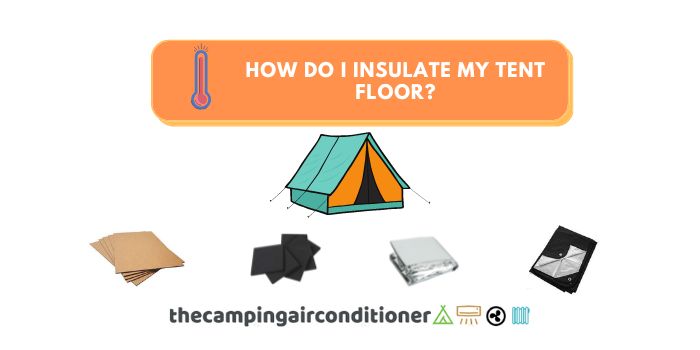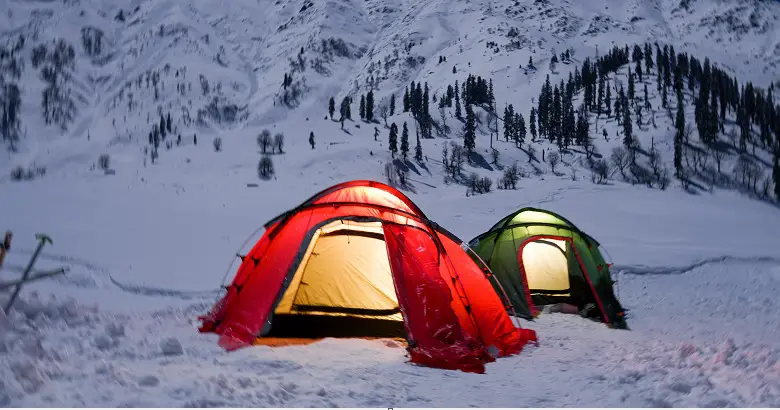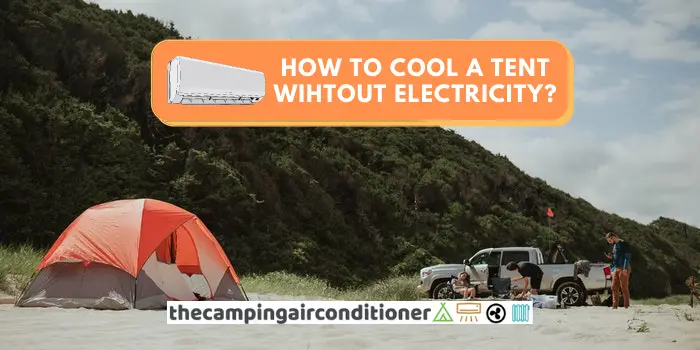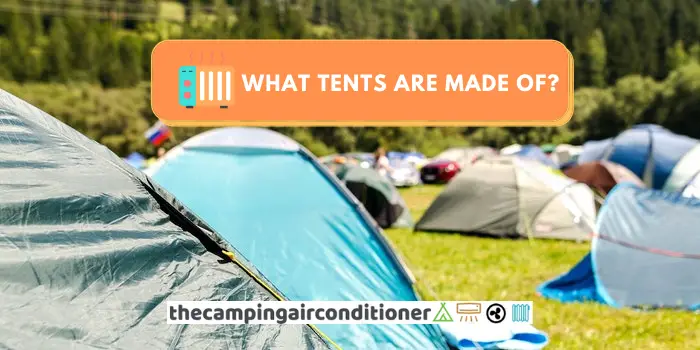Camping is a blessing – we are always looking forward to our next trip and searching for new ways to improve our experience. Insulating your tent’s floor will certainly improve thermal comfort levels and make your shelter cozier!
But how do you insulate your tent floor? You just need to create a layer with insulating material, such as blankets, cardboards, foam pads, or heating blankets, and properly position it to ensure optimal thermal performance.
Apart from the thermal control benefits, floor insulation might also help to control humidity and eliminate condensation problems, giving you the peace of mind that you are staying in a warm and dry environment.
Keep reading this article to understand why you should pay attention to insulation, which materials you should use, and how to use them correctly.

By the way, The Camping Air Conditioner is sponsored by readers. When you buy through one of our links, we may earn an affiliate commission at no extra cost to you.
Why should you insulate your tent floor?
The benefits for a camper are many, such as:
1. Warmth
Insulating the bottom of your tent ensures better temperature control and a warmer environment, especially if you are camping in freezing temperatures (by the way, if you are planning to go camping in the snow, check this article snow camping hacks).
Depending on the material and volume of layers deployed (more details below), you can significantly increase temperatures – up to 25 Fahrenheit Degrees, in some cases – since it will trap your body heat inside and prevents any cold air from flowing in.
Another positive side-effect? You will probably use less fuel/electricity for your camping heater.
2. Health
A cold and moist floor can make you uncomfortable and create health issues. This is due to dampness causing irritation to the skin around your feet and knees – especially when it is continuously humid or raining outside.
High humidity can also lead to mold development and spread, creating respiratory problems for allergic and asthmatic people.
If you have a moldy tent, we highly advise you not to use and/or sleep on it unless you altogether remove these microorganisms.
If you ever notice mildew growth in your gear, clean it immediately with specific products, and ensure there is plenty of ventilation – read this post to learn how to prevent and remove mold from your gear.
3. Tent and camping gear life-span
If your tent is not all-weather or a 4-season tent, it might not be well prepared to face cold, wet and windy conditions.
By not insulating your tent floor, you also might increase the condensation rates inside your shelter, which is not ideal for a camper, especially during winter. Why?
First, Your tent fabric (and floor) might not support the temperatures, and you might risk waterproofing deterioration and fabric tearing due to the combination of moist and cold temperatures. Similarly, your camping gear, such as sleeping bags and clothes, might be drastically affected.
Things can get even worse if you do not use an adequate heater inside your heater, as gas heaters tend to release water in the air as a consequence of gas combustion (in this post, we advise you which heaters might lead to higher condensation).

What material should I use for insulating my tent floor?
There are a couple of options, which includes:
1. Blankets – Blankets are probably the first floor insulation approach that comes to mind. They are not only easy to use, but they will keep you warm and comfortable during the night. Further, you can easily fold and store them and make them adapt to any shape, apart from providing an extra cushion layer. The disadvantages: they might easily get dirty and wet by absorbing humidity.
2. Cardboard – While cardboard might seem like a strange option for insulating your tent floor, it is actually one of the easiest methods available. All you have to do is take and cut up old cardboard boxes into thin sections that can be placed on your tent’s floor. The more layers of cardboard you put down, the better insulated your tent will be.
3. Foam pads – Foam pads are probably the best way to go because they are easy to store and transport. They are soft enough and will also provide extra comfort when you are lying down over them.
4. Heating blankets – If you want the ultimate insulation for your tent’s floor, heating blankets might be the way to go. These special blankets can be plugged into your car’s cigarette lighter or any 12-volt device that you have in your tent (see option below).
When in use, heating blankets provide comfort and warmth for people who are camping in extremely cold areas or for those who feel the cold in their bones easily – be careful, though – I wouldn’t sleep with them turned on the whole night (pick an option with timing function, as SJC Electric Blanket).
- Soft material Size
- Timing Function - 30/45/60 minute timing function.
- Fast Heating and 12-v compatible
- Hand Washable
5. Rugs and clothes – While you can use rugs and clothes to insulate your tent floor, they will provide minimal insulation and are probably the less effective way. The best way to improve the insulating power of your rugs and clothes is to add multiple layers of clothing or blankets.
6. Sleeping bags – Sleeping bags are a great way to add extra insulation to your tent floor. If you have a sleeping bag with thick padding for the inside, this will be ideal for your purposes. Another great way is to use old sleeping bags is by cutting them up into sections and putting them on top of one another.
7. Tent Tarps – A tarp with waterproofing features can significantly improve your insulation against cold weather and moisture, and it is a very cheap investment, costing less than $20 (as this model). Make sure to check the dimensions to ensure the whole floor is protectec.
How to insulate your tent floor?
After picking your preferred insulation material, it is time to use it (we note that you can use more than one option combined to increase thermal comfort – in fact a combined solution is the most efficient way to go).
Follow these steps:
- Lay down your tent tarp and pitch your tent over it.
- Make sure that your tent is in tip-top shape before adding any insulating material. A leaky tent will only cause more trouble as the moisture from the outside will seep into your sleeping area and worsen things.
- You might need several insulating layers if you decide to go ahead with blankets or cardboard options – place them carefully and in an organised manner so they are flat and there is no uneven surface on the floor (it might cause back pain).
- On the other hand, foam pads are very efficient, and one block might be sufficient. They are flat by nature and easy to set up.
- Position your sleeping bag or pad above the layers, and you are ready to have a cozy night.
Editor’s Note: If you plan on using a tent heater during cold nights, make sure you comply with all safety requirements, such as ensuring minimal ventilation for portable gas heaters – read this article to learn how to use heaters inside your tent safely.
Additional tips to keep warm in a tent
1. Consider buying a four-season tent – These days, there are tents specially designed to support cold weather and harsh winter conditions. They are known as 4-season tents, such as NatureHike Cloud Up (2 and 3 person models available), and come with outstanding waterproofness.
- 4 Season Tent - double layers
- Waterproofness - 4000mm (one of the highest in the market)
- Weight - 4.18lb
- Good value for money
2. Pick a canvas tent (if possible) – If you are camping in a big group or for long term, choose a canvas tent since they provide better insulation, and some models, such as WhiteDuck Avalon, come with stove jacks that allow the use of a portable woodstove inside your tent.
However, if you are on a short trip or backpacking, a canvas model might not be ideal (heavier and longer to set up)
3. Always pitch and keep your tent in a dry area where it will be safe from water damage. This can prevent mold, mildew, and rotting of your tent.
4. Be sure that your tent floor is flat and solid. If your tent floor dips or rocks from side to side, this can cause weight shifts that could damage your tent and even cause leaks that could break your insulation.
5. Make sure your sleeping bag is clean and dry before using it or storing it at night.
6. Wear layers of clothes and bring an electric blanket – This is especially important if you are not using a 4-season insulated model. The more layers you have on, the warmer you will be – wear fabrics that provide maximum warmth, such as wool and thermal layers.
7. If you are using a gas camping heater, make sure that you pay attention to safety measures, which include constant ventilation and airflow to avoid carbon monoxide poisoning (read more tips in this article)
8. If camping in extreme weather conditions, it might be worth considering a tent insulation liner.
Final Thoughts
Insulating your tent floor is an easy way to improve comfort in a tent during freezing conditions. You can easily do it with camping gear that you already have or are extremely affordable, as shown above.
If you are camping in extreme weather, a 4-season tent or a canvas model might be worth considering – both come with outstanding insulation features.
And before we forget, bring a suitable heater to ensure a cozy and warm night.






